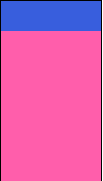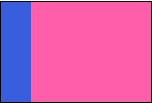最新更新时间:2019年08月12日10:42:15
《猛戳-查看我的博客地图-总有你意想不到的惊喜》
本文内容:css布局相关知识
顶部元素固定高度,下方内容元素撑满剩余高度
- dom结构如下
<body>
<div id="parent">
<div id="child1"></div>
<div id="child2"></div>
</div>
</body>
- 预期效果,如下图

- 方案一:父元素设置padding-top,上元素和下元素设置相对定位,下元素设置高度100%
<style>
#parent{
width: 100px;
height: 150px;
border: 1px solid black;
padding-top: 30px;
}
#child1{
height: 30px;
background: #4169E1;
position: relative;
top: -30px;
}
#child2{
background: #FF69B4;
height: 100%;
position: relative;
top: -30px;
}
</style>
- 方案二:父元素设置padding-top,上元素设置margin-top,下元素设置高度100%
<style>
#parent{
width: 100px;
height: 150px;
border: 1px solid black;
padding-top: 30px;
}
#child1{
height: 30px;
background: #4169E1;
margin-top: -30px;
}
#child2{
background: #FF69B4;
height: 100%;
}
</style>
- 方案三:下元素设置绝对定位且不设置高度
<style>
#parent{
width: 100px;
height: 150px;
border: 1px solid black;
position: relative;
}
#child1{
height: 30px;
background: #CCFF33;
}
#child2{
background: #fc9153;
position: absolute;
top: 30px;
left: 0;
bottom: 0;
right: 0;
}
</style>
- 方案四:下元素使用css函数calc()动态设置高度
<style>
#parent{
width: 100px;
height: 150px;
border: 1px solid black;
}
#child1{
height: 30px;
background: #4169E1;
}
#child2{
background: #FF69B4;
height: calc(100% - 30px);
}
</style>
- 方案五:整体使用flex布局
<style>
#parent{
width: 100px;
height: 150px;
border: 1px solid black;
display: flex;
flex-direction: column;
}
#child1{
width: 100%;
flex-basis: 30px;
background: #4169E1;
}
#child2{
background: #FF69B4;
flex: 1;
width: 100%;
}
</style>
左侧元素固定宽度,右侧内容元素撑满剩余宽度
- dom结构如下
<body>
<div id="parent">
<div id="child1"></div>
<div id="child2"></div>
</div>
</body>
- 预期效果,如下图

- 方案一:左元素设置左浮动,右元素设置margin-left
<style>
#parent{
width: 150px;
height: 100px;
border: 1px solid black;
margin: 400px;
}
#child1{
width: 30px;
height: 100%;
background: #4169E1;
float: left;
}
#child2{
background: #FF69B4;
height: 100%;
margin-left: 30px;
}
</style>
- 方案二:左右元素设置为行内块元素,右元素使用css函数calc()动态设置宽度
<style>
#parent{
width: 150px;
height: 100px;
border: 1px solid black;
font-size: 0;/* 消除inline-block元素的横向间距 */
}
#child1{
width: 30px;
height: 100%;
background: #4169E1;
display: inline-block;
}
#child2{
background: #FF69B4;
width: calc(100% - 30px);
height: 100%;
display: inline-block;
}
</style>
- 方案三:左元素左浮动,右元素创建BFC
<style>
#parent{
width: 150px;
height: 100px;
border: 1px solid black;
}
#child1{
width: 30px;
height: 100%;
background: #4169E1;
float: left;
}
#child2{
background: #FF69B4;
height: 100%;
overflow: hidden;/* 创建块级格式化上下文:具有overflow 且值不是 visible 的块元素*/
}
</style>
- 方案四:整体使用flex布局
<style>
#parent{
width: 150px;
height: 100px;
border: 1px solid black;
display: flex;
}
#child1{
flex-basis: 30px;
height: 100%;
background: #4169E1;
}
#child2{
background: #FF69B4;
height: 100%;
flex: 1;
}
</style>
参考资料
- 无
感谢阅读,欢迎评论^-^
打赏我吧^-^
最后
以上就是腼腆猫咪最近收集整理的关于顶部(左侧)元素固定高度(宽度),内容(下方/右侧)元素撑满剩余高度(宽度)的全部内容,更多相关顶部(左侧)元素固定高度(宽度)内容请搜索靠谱客的其他文章。
本图文内容来源于网友提供,作为学习参考使用,或来自网络收集整理,版权属于原作者所有。








发表评论 取消回复